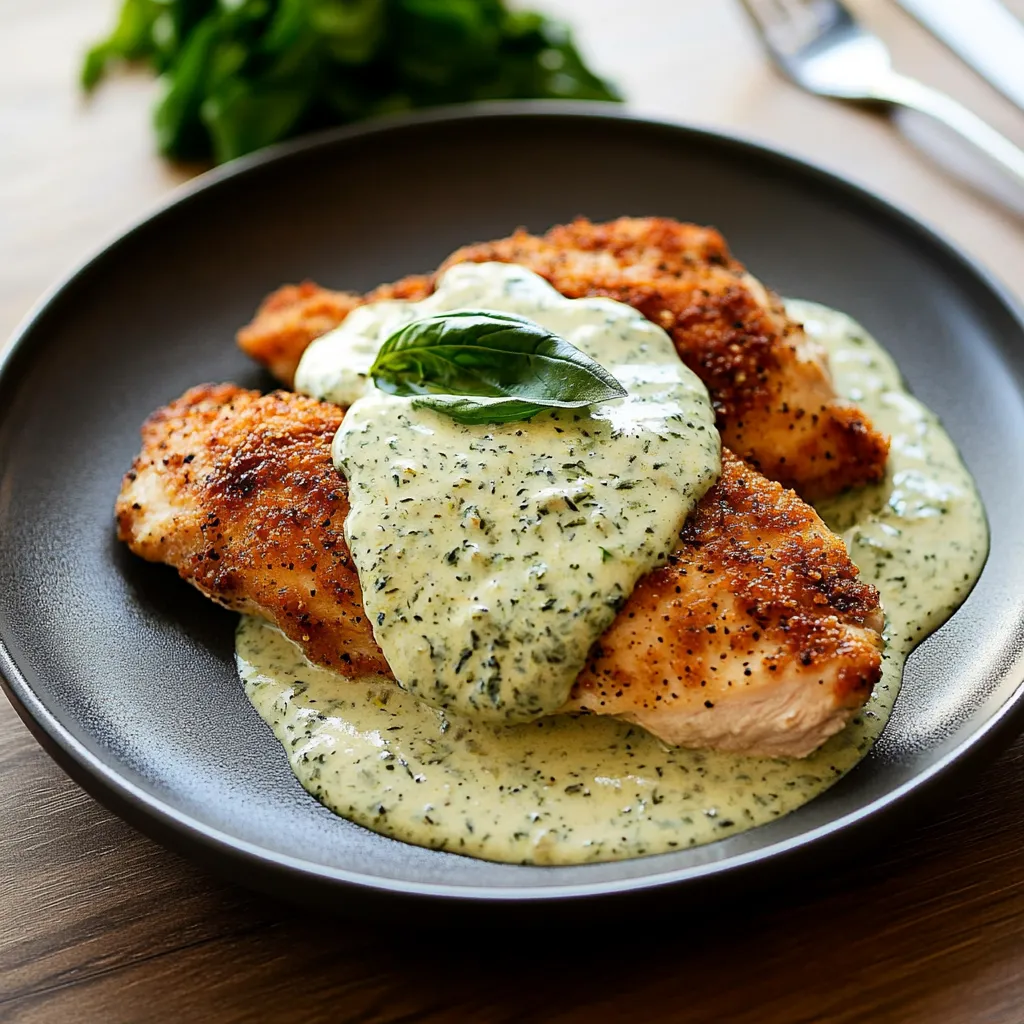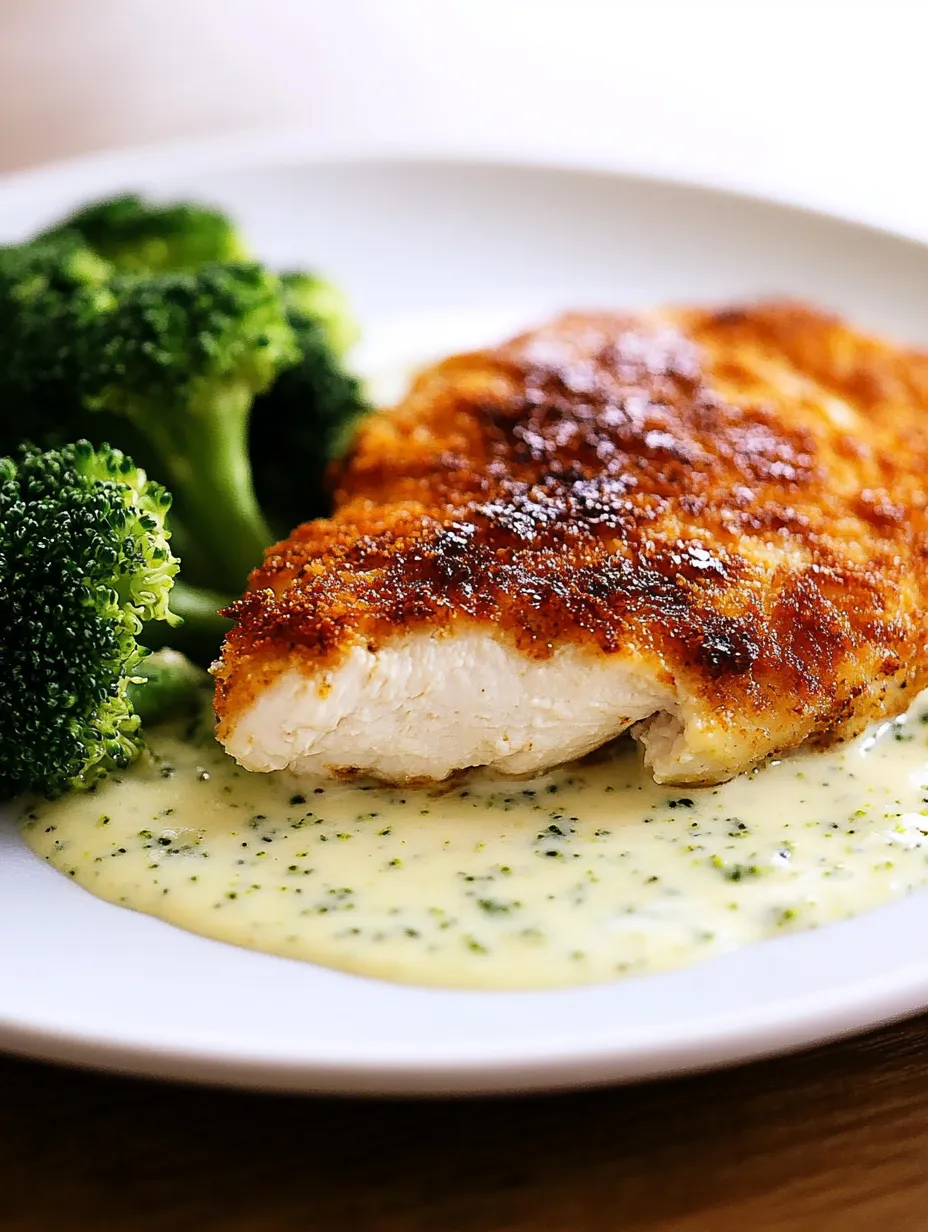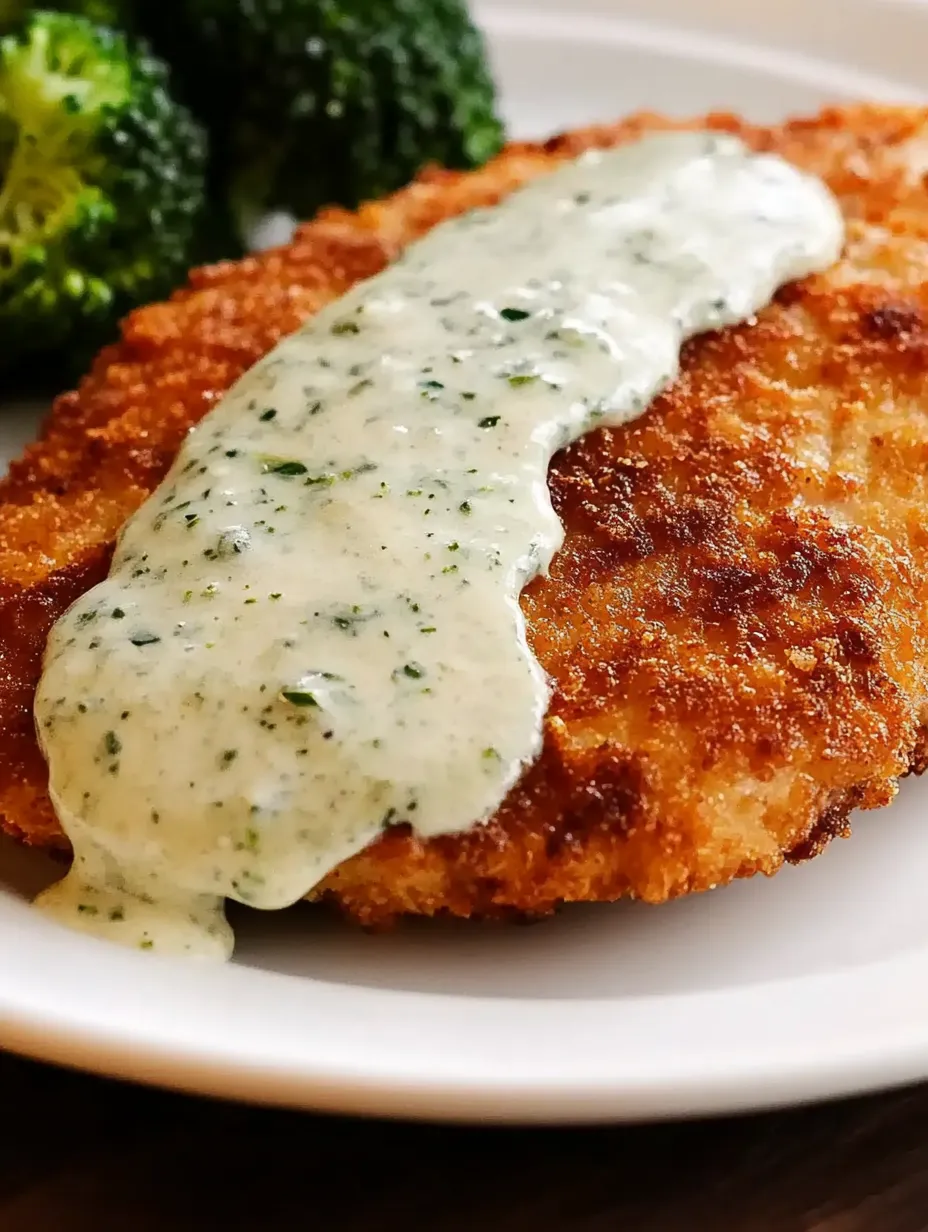 Pin it
Pin it
Italian Comfort Elegance
This extraordinary chicken dish transforms humble cutlets into a restaurant worthy experience through the magic of a velvety basil cream sauce that elevates every bite. The contrast between the crispy, golden exterior of the chicken and the silky, herb infused sauce creates perfect textural harmony that delights the palate. I discovered this recipe after attempting to recreate a memorable meal from a tiny Italian restaurant where the grandmother still cooked in the kitchen well into her eighties.
Dinner Excellence
My journey with this dish began after a vacation in northern Italy where similar preparations appeared on menus in small family restaurants. What started as an attempt to recapture vacation memories has become my most requested dinner party recipe. Even my mother, who typically avoids cream sauces, requests this dish whenever she visits. The first time I served it to guests, conversation stopped completely for several minutes as everyone focused entirely on their plates, which I consider the highest possible culinary compliment.
Quality Components
- Chicken Breasts (2 large): Create the perfect canvas for the flavorful coating and sauce, with proper preparation ensuring tenderness throughout
- Italian Breadcrumbs (3/4 cup): Provide essential crispy texture and seasoned flavor foundation that complements rather than competes with the sauce
- Heavy Whipping Cream (1 cup): Creates the luxurious sauce base with silky texture and richness that cannot be achieved with lighter dairy alternatives
- Fresh Basil (1/4 cup chopped): Delivers bright, aromatic notes that define this dish and elevate it beyond standard cream sauces
- Parmesan Cheese (1/2 cup grated): Contributes savory depth and natural thickening power through its aged umami characteristics
- Garlic (2 cloves): Forms the aromatic foundation that permeates the entire sauce with gentle pungency that mellows during cooking
 Pin it
Pin it
Restaurant Technique
- Chicken Preparation:
- Begin by properly preparing the chicken for even cooking and optimal texture. Preheat your oven to 275°F, which will later be used to finish cooking the chicken gently without drying it out. Place each chicken breast on a cutting board and, with your hand flat on top, carefully slice horizontally through the middle to create two even cutlets from each breast. Place the cutlets between sheets of plastic wrap or parchment paper and gently pound with a meat mallet or heavy bottomed pan until they reach an even 1/2 inch thickness throughout. This uniform thickness ensures even cooking while the pounding naturally tenderizes the meat. Pour 1/2 cup milk into a shallow dish and place 3/4 cup Italian breadcrumbs in another. Dip each cutlet first in the milk, allowing excess to drip off, then press firmly into the breadcrumbs, ensuring complete coverage on both sides. This double coating creates the perfect foundation for the crispy exterior that will contrast beautifully with the cream sauce.
- Perfect Searing:
- Heat 3 tablespoons butter in a large skillet over medium heat until melted and beginning to foam but not brown. The butter provides rich flavor to the coating while promoting even browning. Place the breaded cutlets in the skillet without overcrowding, working in batches if necessary to maintain proper spacing. Cook for approximately 3 minutes on each side until golden brown but not fully cooked through, as they will finish cooking in the oven. Transfer the partially cooked cutlets to a baking sheet and place in the preheated oven for 5 to 7 minutes while preparing the sauce. This gentle oven finishing ensures the chicken reaches the proper internal temperature of 165°F without overcooking the exterior, maintaining juiciness throughout. The low temperature prevents the coating from becoming too dark while allowing the interior to cook perfectly.
- Sauce Development:
- Using the same skillet with the flavorful browned bits from cooking the chicken, reduce heat to medium low and add the minced garlic, sautéing just until fragrant, approximately 30 seconds. Be careful not to brown the garlic, which would introduce bitterness to the sauce. Add 1/2 cup chicken broth to the pan, using a wooden spoon to scrape up all the browned bits from the bottom of the skillet. These browned bits contain concentrated flavor that will enhance the entire sauce. Allow the broth to simmer for approximately 1 minute, reducing slightly before adding 1 cup heavy whipping cream. Bring this mixture to a gentle simmer, stirring occasionally, until it begins to thicken slightly, about 3 to 4 minutes. The sauce should coat the back of a spoon but still maintain a pourable consistency.
- Final Harmony:
- Once the sauce has begun to thicken, stir in 1/2 cup freshly grated Parmesan cheese, 1/4 cup chopped fresh basil, and 1/4 teaspoon black pepper. Continue simmering gently while stirring constantly until the cheese has fully melted and incorporated into the sauce, creating a smooth, velvety texture. Taste and adjust seasoning if needed, though the Parmesan typically provides sufficient saltiness without additional salt. Remove the chicken from the oven and arrange on a serving platter or individual plates. Spoon the hot basil cream sauce generously over each cutlet, allowing some to pool around the edges for an attractive presentation. Garnish with additional fresh basil leaves and a light sprinkle of grated Parmesan if desired. Serve immediately while the chicken is crisp and the sauce is warm and flowing.
I particularly treasure the versatility of this recipe. Growing up, my mother rarely prepared cream sauces, considering them too heavy and challenging to execute properly. Learning to make this dish taught me the importance of gentle heat and patience when working with cream. The first time my Italian neighbor tried my version, she nodded silently before sharing that her own mother made something similar, which I consider the highest possible authenticity endorsement. When teaching my teenage nephew basic cooking skills, this was the first "impressive" dish in his repertoire, building his confidence tremendously when he successfully served it to his parents for their anniversary dinner.
Magnificent Meal
This versatile dish welcomes numerous accompaniments depending on the occasion and season. For an elegant dinner, serve alongside roasted asparagus spears and wild rice pilaf that provide color contrast while complementing the creamy sauce. Summer gatherings call for pairing with a simple arugula salad dressed with lemon vinaigrette, allowing its peppery notes and acidity to balance the richness. For heartier appetites, consider serving over angel hair pasta which catches the sauce beautifully in its delicate strands. Garlic bread makes an excellent addition for casual family meals, perfect for enjoying every last bit of the remarkable sauce. When entertaining guests, add a small side of roasted cherry tomatoes that burst with brightness against the creamy background flavor.
Creative Adaptations
This foundation recipe welcomes numerous variations based on preference or available ingredients. For a spinach basil version, add 2 cups fresh spinach to the sauce during the final minute of cooking, allowing it to wilt gently into the cream. Those enjoying stronger garlic presence might roast a full head of garlic and incorporate the softened cloves into the sauce for deeper flavor without pungency. Seafood enthusiasts could substitute thin fish fillets or large shrimp for the chicken, reducing cooking time accordingly. The herb profile adapts beautifully to what's available, with tarragon, thyme, or sage creating entirely different but equally delicious variations. For a lighter version, replace half the cream with additional chicken broth and add 1 teaspoon of cornstarch slurry to maintain proper thickness. Those avoiding dairy entirely might experiment with coconut cream and nutritional yeast as alternatives, though the flavor profile shifts to a more tropical direction.
 Pin it
Pin it
Storage Solutions
While this dish reaches its peak when freshly prepared, leftovers can be properly stored and enjoyed later. Store chicken and sauce separately when possible, keeping both in airtight containers in the refrigerator for up to three days. To reheat, warm the sauce gently in a small saucepan over low heat, stirring occasionally and adding a splash of milk or cream if it has thickened too much during storage. Place the chicken on a baking sheet in a 300°F oven until heated through, approximately 10 minutes, which helps maintain some crispness in the coating. Avoid microwave reheating which tends to make the chicken coating soggy and may cause the cream sauce to separate. For meal planning purposes, the chicken can be breaded up to a day in advance and stored covered in the refrigerator, though it should be brought to room temperature for 20 minutes before cooking for best results.
After perfecting this recipe through countless iterations, I've come to appreciate it as more than just delicious food but rather as a perfect example of how simple ingredients transform through proper technique. What begins as basic chicken breasts becomes something truly special through the careful layering of texture and flavor. The contrast between the crisp exterior and tender interior of the chicken against the silky sauce creates a dining experience that feels far more sophisticated than the ingredient list might suggest. While restaurant versions often disappoint with heavy, floury sauces or dry chicken, this homemade version consistently delivers perfect balance and texture that reminds us why classics become classics in the first place.
Frequently Asked Questions
- → What's the best way to cut chicken breasts into cutlets?
- To cut chicken breasts into even cutlets: Place your hand flat on top of the chicken breast, and using a sharp knife, slice horizontally through the middle of the breast, parallel to your cutting board. Start at the thicker end and work toward the thinner end, keeping your knife parallel to the cutting board. For more even cutlets, place plastic wrap over the sliced breasts and gently pound with a meat mallet until they reach an even 1/2-inch thickness. This ensures they cook at the same rate and remain tender and juicy.
- → Can I substitute the heavy cream with something lighter?
- While heavy cream creates the richest, most luxurious sauce, you can substitute half-and-half for a lighter version. The sauce won't be quite as thick, but will still be delicious. For an even lighter option, you could use evaporated milk, though you may need to thicken it slightly with 1 teaspoon of cornstarch mixed with 1 tablespoon of cold water. Avoid using regular milk as it's likely to curdle. Non-dairy alternatives like full-fat coconut milk can work but will add a slight coconut flavor to the dish.
- → Why is the oven temperature so low at 275°F?
- The unusually low oven temperature of 275°F is intentional and serves an important purpose. After the chicken develops a golden-brown crust in the skillet, this gentle heat allows it to finish cooking slowly and evenly throughout without drying out or overcooking the exterior. This method ensures the chicken remains incredibly tender and juicy while giving you time to prepare the sauce. It's similar to the low-temperature cooking method used in fine restaurants to achieve perfectly cooked proteins.
- → What can I serve with Chicken in Basil Cream Sauce?
- This versatile dish pairs beautifully with many sides. For starches, consider angel hair pasta, garlic mashed potatoes, or buttered rice to soak up the delicious sauce. For vegetables, roasted asparagus, sautéed green beans, or a simple side salad with lemon vinaigrette provide a nice contrast to the rich cream sauce. Garlic bread or a crusty Italian loaf is perfect for mopping up any extra sauce. For a complete Italian-inspired meal, serve with a Caprese salad starter and tiramisu for dessert.
- → Can I make this dish ahead of time?
- While this dish is best enjoyed fresh, you can prepare components ahead of time. The chicken cutlets can be breaded up to 8 hours ahead and stored covered in the refrigerator (though they may not be quite as crispy). The sauce can be made 1-2 days ahead and gently reheated with a splash of cream or chicken broth to bring it back to the proper consistency. For fully assembled leftovers, store in an airtight container in the refrigerator for up to 2 days and reheat gently in a 300°F oven until warmed through.
- → What's the best way to chop fresh basil?
- For the best flavor and presentation when chopping basil, use the chiffonade technique: Stack 5-6 basil leaves, roll them tightly like a cigar, then slice across the roll with a sharp knife to create thin ribbons. For this recipe, gather these ribbons and chop through them once or twice more to create smaller pieces. Always use a sharp knife as a dull one will bruise the delicate leaves and cause them to darken. For maximum flavor, chop the basil just before adding it to the sauce as it begins to lose its aromatic qualities quickly after cutting.
